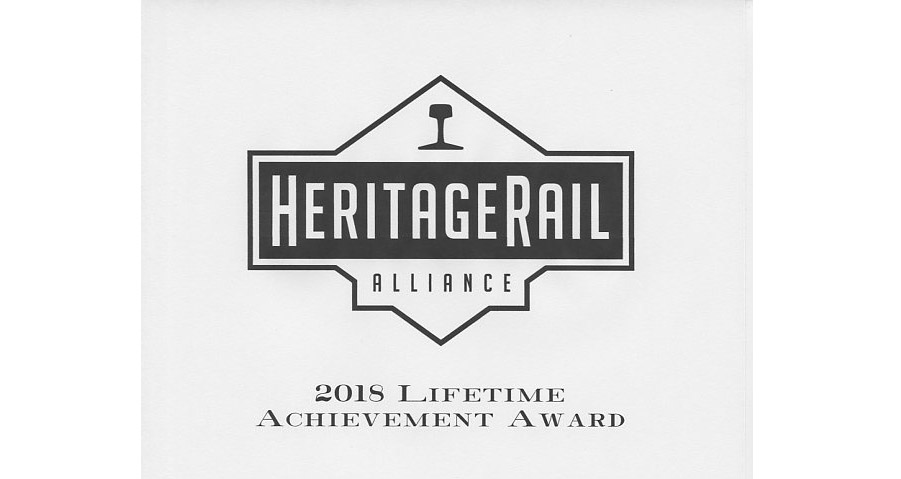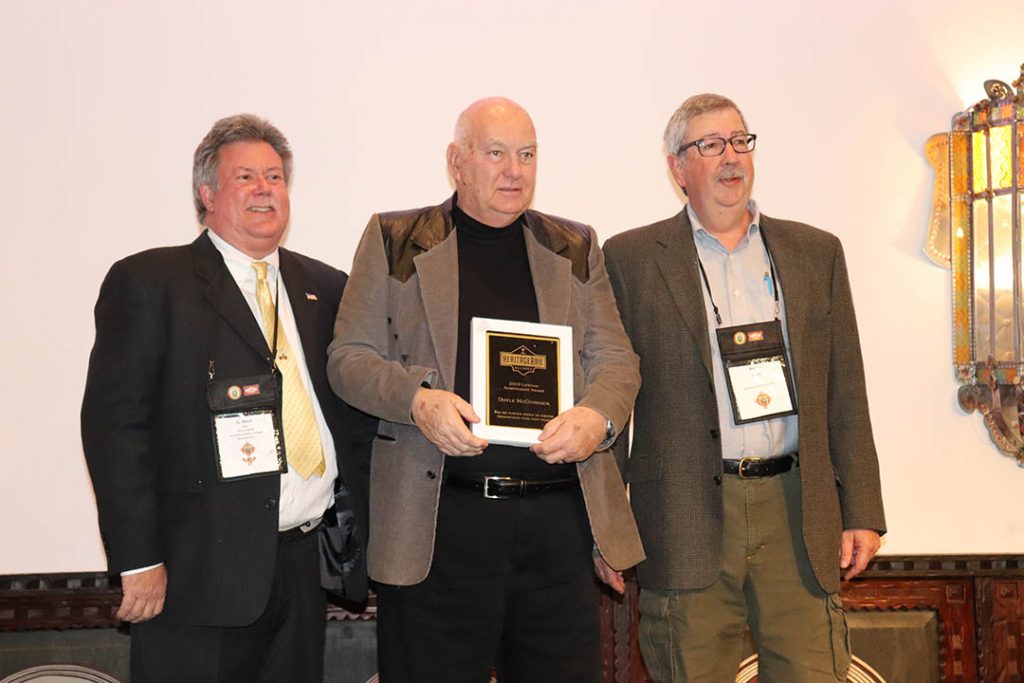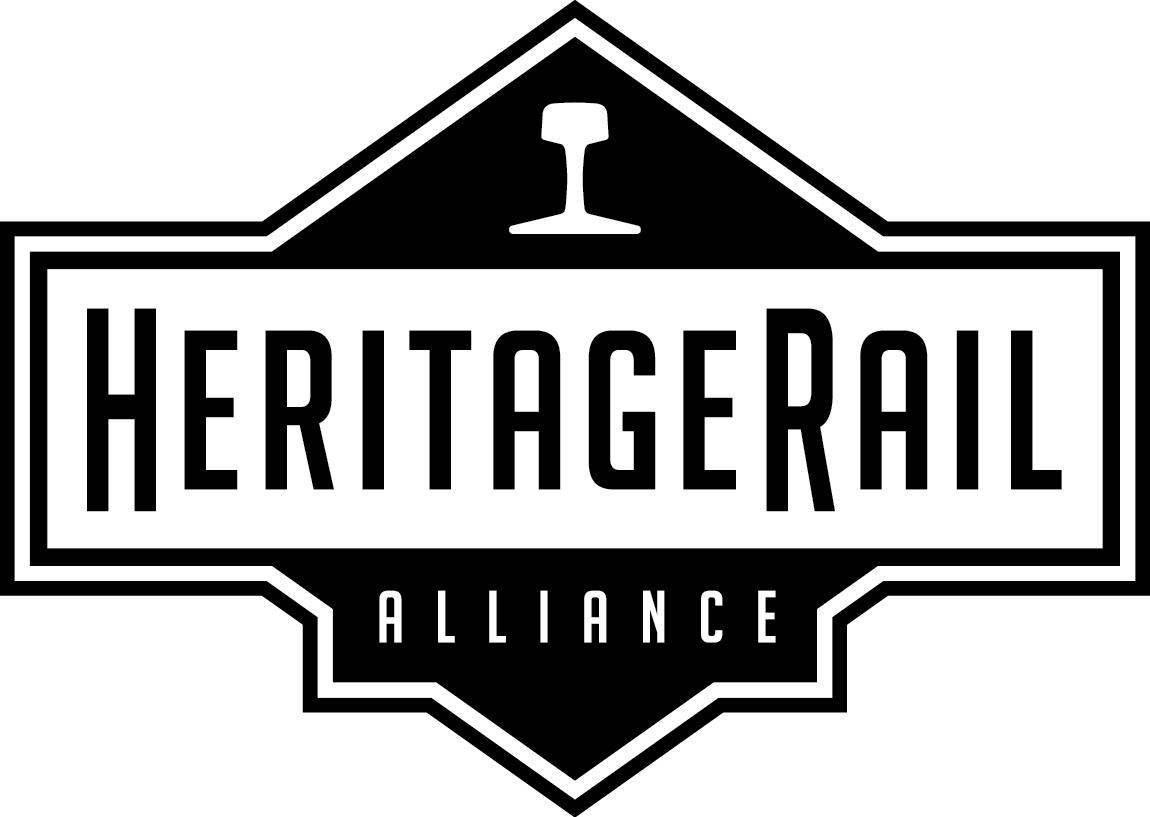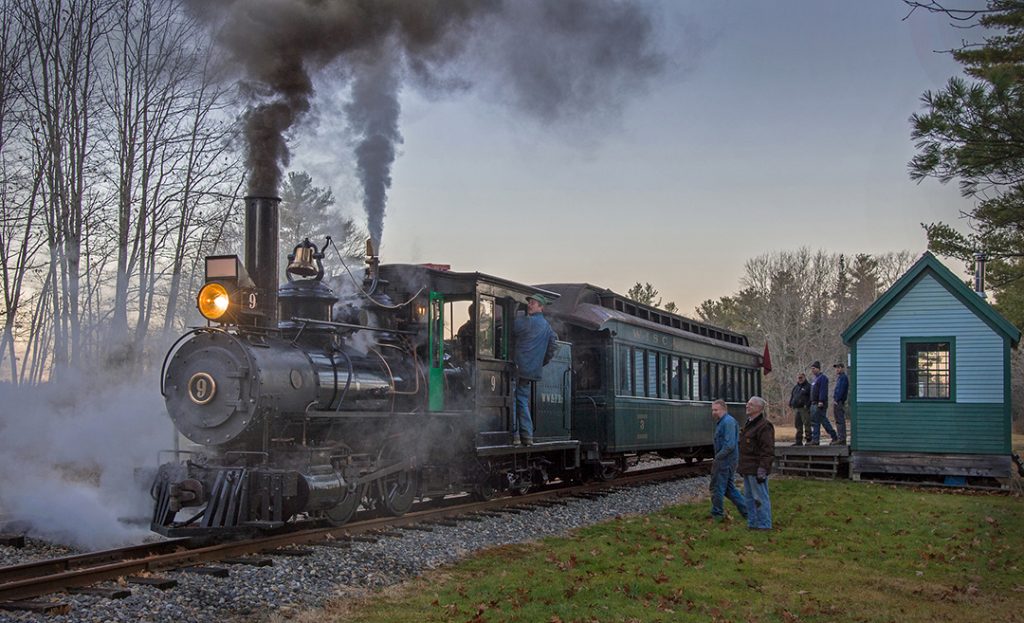
By Aaron Isaacs, HRA editor and Awards Committee Chair
Every year at the Fall conference banquet, the HeritageRail Alliance presents awards to recognize the best of railway preservation. Previous posts mentioned the Significant Achievement Awards for restorations and other large capital projects. The list this year was:
Steam Locomotives–Age of Steam Museum for Morehead & North Fork 0-6-0 #12
Diesel Locomotives–Orange Empire Railway Museum for Santa Fe FP45 #108
Electric Cars–Pennsylvania Trolley Museum for West Penn interurban #832
Passenger Cars–Cumbres & Toltec Scenic Railroad for Rio Grande narrow gauge coach #292
Freight Cars–Friends of the Cumbres & Toltec for restoring 40 freight and maintenance of way cars over the last 10 years.
Structures–Wiscasset Waterville & Farmington Railroad Museum for the former Boston & Maine Moose Brook bridge reuse.
Archives–Canadian Railway Historical Association for its acquisition of the Canadian Pacific corporate records
Individual Awards
We also presented awards to individuals for distinguished service to railway preservation.
Friend of Railway Preservation
This award goes to individuals who are not part of the museum or tourist railroad community, but have extended help when it was most needed. In 2017 Wick Moorman of Norfolk Southern was honored for all the help NS gave museums with equipment restorations and special train movements.
This year the award went to the Ramsdell Family for preserving what would become the core of the Wiscasset, Waterville & Farmington Railway Museum. After the WW&F was abandoned in 1933, they saved 0-4-4T #9 (Portland 1891) and flatcar #18 and stored them in a barn at their farm in West Thompson, Connecticut.
They kept them a secret during the World War II scrap drives. They eventually donated them to the new museum, where they have been restored to operation and provided the spark that has led to the rebuilding of a significant portion of the WW&F on the original right of way.
William Purdie Awards for encouraging youth involvement
Bill Purdie was the head of the Southern Railway steam program and he mentored an entire generation of young steam mechanics. HRA President G. Mark Ray proposed the award for encouraging youth involvement in Purdie’s name, but for two years we failed to identify candidates to receive it. That changed this year when we put a call for nominations on RyPN.org.
We received four nominations and all were deserving, so we gave four awards. Well, one of them was shared. They are:
Tom Schneider and Jason Maxwell, Illinois Railway Museum.
Although nominated separately, Schneider and Maxwell are respectively the curator and assistant curator of the IRM Steam Shop. Schneider has been at it for 35 years. Maxwell is the younger of the two. To quote one of the nominations, “IRM has a huge number and variety of volunteers of all ages and backgrounds. However I think it’s fair to say that the steam shop has, on the whole, the lowest average age. There are at least a dozen guys under thirty that work in the shop. A large percentage of them are actually involved in operations – everything from prepping the locomotive on service days to being brakemen all the way up to student and qualified engineers.” Referring to Schneider, the nomination said, “He’s gone out of his way to make sure the younger, less experienced volunteers are always working on something and learning new skills.”
Bruce Mowbray, Steamtown
It could be argued that steam is often the entry-level attraction that brings young people into railway preservation, and that seems true at Steamtown, where Mowbray heads the shop. The nomination says “My age is 33, Jerry is 34, Mike and Brian are 39. The ages of his volunteers span from 19 to people in their 50s. I’m working on a program with him for teens under 18 to do painting and other safer projects soon. Bruce has taught many us welding, riveting, cutting with a torch, how to use many tools and heavy machinery. We have jokingly called him our Steamtown dad.”
Ed Kohler, Tri-State Railway Historical Society
A former Eagle Scout and a longtime scoutmaster, Ed conducts Railroading Merit Badge classes and created the Boy Scout Engineering Award which can be earned by Cub Scouts, Boy Scouts, and (starting in 2018) Girl Scouts at the United Railroad Historical Society’s annual museum event in Boonton, NJ. According to the nomination, “His talks at scouting events has led to an influx of younger audiences at Tri-State events and a group of younger volunteers that actively maintain New Jersey’s railroad history. Tri-State’s annual Santa Train in December now includes participation by the choir and business club from Ed’s local James Caldwell High School, with which he coordinated to promote youth involvement in this special annual railroading event.”
Lifetime Achievement Awards
This is an industry where volunteers often devote their entire adult lives and every museum usually has one or more patriarchs or matriarchs. Having so many deserving candidates makes each year’s selection difficult. We tried to select people who have had a national impact that reached beyond their local institutions.
Linn Moediger, Strasburg Rail Road

Linn Moedinger (left) had to leave the conference early, so he received his award from HRA President G. Mark Ray at the Chama depot.
The timing couldn’t be better for this award. Linn Moedinger had just announced his retirement after 50 years with the Strasburg, rising to the positions of Chief Mechanical Officer and President. During his tenure he established the Strasburg as a paragon of historically accurate tourist railroading, featuring a stable of steam locomotives and a spotless fleet of mostly wood passenger cars. Beyond that, he built the Strasburg shop into an important restoration contractor, working on projects from across North America. His impact went beyond Pennsylvania. As stated in the nomination, “He is a charter member of the Engineering Standards Committee, which may well have saved steam railroading in the United States after the 1995 Gettysburg disaster. Since then he has been active on committees belonging to ASME, ASTM, and NBIC among others, updating and in some cases reintroducing locomotive boiler codes to make our jurisdictions into partners instead of adversaries.” Finally, he was one of the midwives of the ARM/TRAIN merger that created the HeritageRail Alliance, hosting the first planning meeting and serving on the HRA Board through this year.
Doyle McCormack, Oregon Rail Heritage Foundation

Doyle McCormack with HRA President G. Mark Ray (left) and HRA editor and Awards Committee chair Aaron Isaacs (right). Tim Crain photo.
There would have been no Southern Pacific 4449 pulling the American Freedom Train or its other triumphant appearances without Doyle McCormack. His stewardship of that iconic locomotive put railway preservation on the map in an unprecedented way. The public liked what it saw and that reservoir of good will has helped the industry and encouraged others to enter the field. When the SP finally demolished its old roundhouse in Portland, McCormack led the Oregon Rail Heritage Foundation’s successful move to a new building where the public can view 4449, her two steam sisters and McCormack’s other icon, the only restored Alco PA anywhere.
Ted Anderson, Illinois Railway Museum’s Pullman Library
Anderson is being recognized for his efforts to develop the museum’s Pullman library into an international resource for preservationists. This from his nomination. “While working to restore a Boston & Maine coach , Ted decided that he should try to locate the original drawings for the cars, which were somewhere in the stacks of Pullman material which IRM had acquired. A couple volunteers had been developing the library for quite a while, but there were issues with finding anything at that time. Ted began to shift his energies to searching through and organizing the Pullman library, which later became his full-time vocation. Ted realized what a gem these resources were, and how people should have access to them in order to complete more accurate restorations. He developed systems of cataloging, copying, archiving, reproducing, communicating, acquiring funds, promoting, and linking the Pullman collection. He developed relationships between many libraries and restoration projects. He also worked with Bombardier to gain the remainder of the collection in their holdings. Ted researched and learned of additional private collections of Pullman resources, and managed to fold many into the IRM collection.”


